
The Devil Bugs Are Back (5 June 2011)They're obnoxiously loud; have creepy big red eyes; and every few years come pouring out of the ground in the billions to sing, mate, lay eggs and die. One of my nieces calls them "Devil Bugs". She's not fond of them, and she's not alone. Many have strong negative feelings about them, or even fear them. What are they? They're cicadas, and a large part of the U.S. is quite literally crawling with them right now. 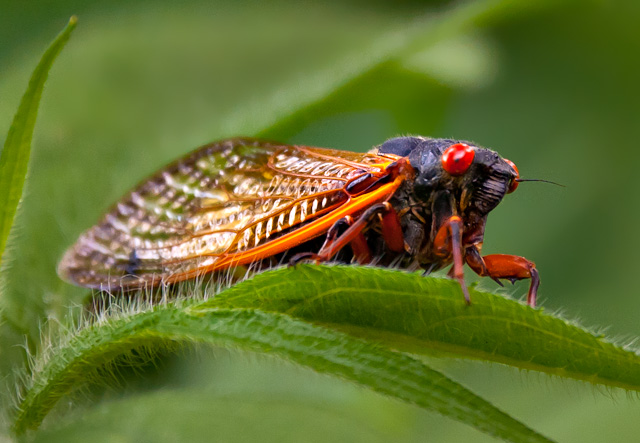
I Stare At It; It Stares At Me. I Wonder What's Going On In This Cicada's Brain. (Nikon D700 @ ISO 3200; Nikon 28-300 @ 300mm, F/8; 1/500 Sec, Hand Held, VR Assist; Cropped) There are two broad categories of cicadas here in the U.S: annuals, which appear in relatively small numbers every summer, and periodicals, appearing in huge numbers every thirteen or seventeen years. Periodicals, in turn, are lumped into broods based on the year they appear, with most years seeing either a thirteen or seventeen year brood, or both. Cicadas appearing now are thirteen-year periodicals from brood nineteen. The life cycle of periodicals is quite intriguing and has been the subject of a lot of research. It starts high in the trees as eggs deposited in the bark hatch. The newly emerged nymphs fall to the ground and tunnel down to a tree root, which they attach to and begin sucking the sap. For thirteen, or seventeen, years, the nymphs remain underground and grow, molting four times in the process. And then, at the appointed time, they emerge and the spectacle begins. 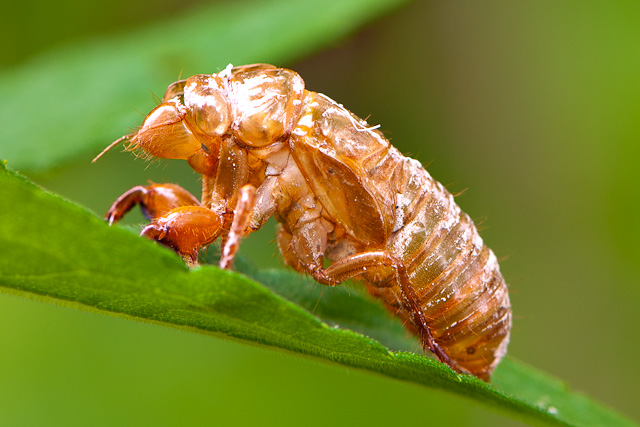
An Empty Husk Left Behind After Molting. (Nikon D3X @ ISO 200; Nikon 105mm Macro @ F/8; 1/13 Sec, Tripod, MLU, Cable Release; Cropped) 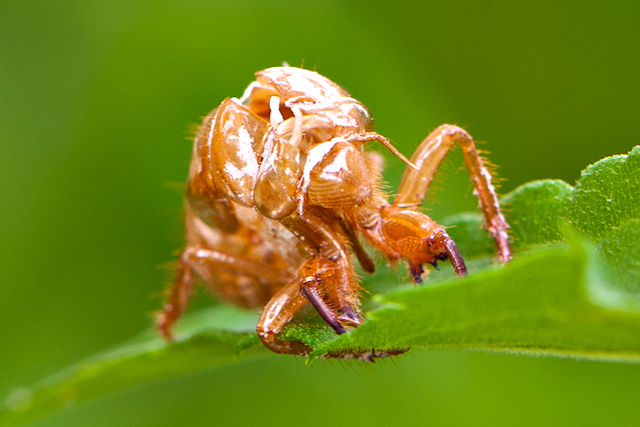
Another View Showing The Split Where The Adult Emerged. It Reminds Me Of The Movie "Alien" :-) (Nikon D3X At ISO 200; Nikon 105mm Macro @ F/8; 1/13 Sec, Tripod, MLU, Cable Release; Cropped) It starts peacefully enough. Newly emerged nymphs find a vertical surface and climb. Once they find a suitable spot, they glue themselves in place and molt one last time. A soft, mostly white adult cicada emerges. Over a few hours the exoskeleton and wings harden and darken. When they're ready, they fly off. About a week after molting, the males start congregating in the tree tops and begin singing. Individual males aren't loud - making a soft tick tick tick tick sound. But when you have thousands of them singing together, the sound becomes deafening. Why are the males singing? To attract females, of course. Like males of all pursuasions, they strutt their stuff and play the fool, all to attact a mate. Think of them as thousands of rowdy construction workers, hanging out in the tree tops, all wolf whisteling and calling out "hey, baby" at the same time. Surprisingly, this technique works (apparently with females of all species :-) The females are smitten by the crooning, fly up into the trees, and the carousing begins. Males don't have a monopoly on going all goofy when it comes to mating. Here's a brief recording of thousands of male cicadas singing in unison (Cicadas Singing). It's not a great recoring - I'm still learning how to do this, plus I had to filter it pretty heavily to get rid of some man-made background noise - but the essence of the sound is there. Note how the sound modulates in volume as the multitude of cicadas synchronize their singing. For best results, listen with headphones (be careful with the volume - it's kinda loud). 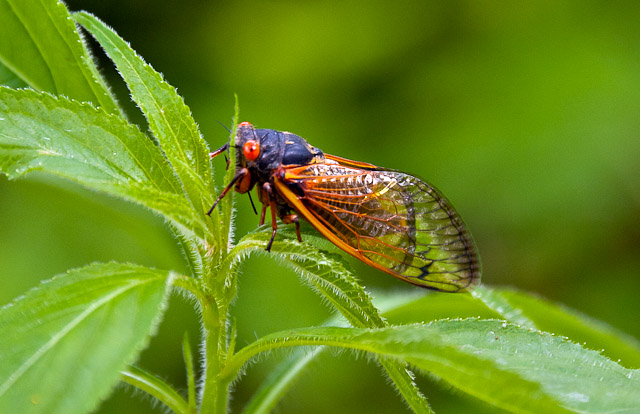
They Are Relatively Approachable In The Cool Of Early Morning (Nikon D700 @ ISO 3200; Nikon 28-300 @ 300mm, F/8; 1/640 Sec, Hand Held, VR Assist; Cropped) 
Striking A Pose (Nikon D700 @ ISO 3200; Nikon 28-300 @ 300mm, F/8; 1/500 Sec, Hand Held, VR Assist; Cropped) While all the singing and mating is going on, the dying is also going on. Predators are feasting on them, creating a vast cicada killing fields. Cicadas are slow and clumsy and easy pickings for birds, dogs, cats, and squirrels. Apparently even pigs love to eat cicadas. But it's not just predators killing them. The cicadas are just plain dying. You see them everywhere, flopping around on their backs, unable to walk or fly anymore. I read in one article that adults die within a few days of mating, but I haven't found that anywhere else. It seems consistent with what I've seen, however. It doesn't take long for the ground to become littered with their remains. This emerging, molting, singing, mating, and dying continues for about a month, until the final nymph emerges and the last adult dies. In the meantime, the females are laying their newly fertilized eggs in the bark of nearby trees. Six to eight weeks later, well after the last adult has died, the nymphs hatch and the thirteen or seventeen year cycle begins all over again. 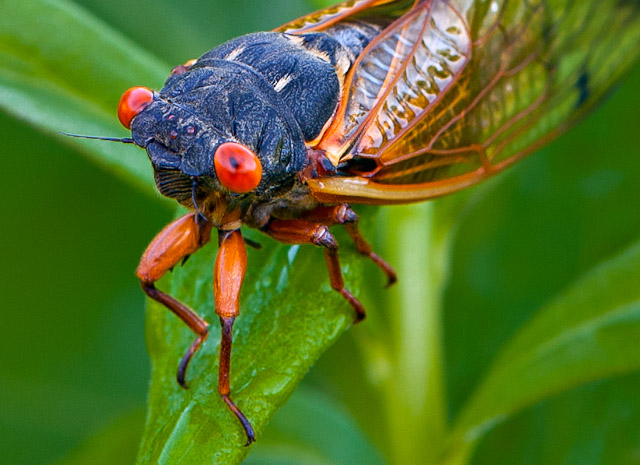
Details Of The Head, Wings, And Legs (Nikon D700 @ ISO 200; Nikon 105mm Macro @ F/11; 1/40 Sec, Tripod, MLU, Cable Release; Cropped) 
Close Up Of The Top Of The Head. Are Those Three Little Dots In The Middle Eyes? (Nikon D700 @ ISO 1600; Nikon 105mm Macro @ F/8; 1/250 Sec, Hand Held, VR Assist; Cropped) A few other tidbits about cicadas before I call it a day. First, they're harmless. They don't bite or sting. They have a long proboscis which some might mistake for a stinger, but it's really just used to drink sap from tree bark. The worst they can do is accidentally land in your hair and make you look foolish as you freak :-) Second, the best time to photograph them is early in the morning, while it's still cool. They seem to be in a bit of a torpor at this time and are easily approached. As the day wears on, they get a lot more active and skittish. Third, I read somewhere (but haven't been able to find it since) that in addition to the two prominent red eyes, they have three smaller eyes on the top of their head. And finally, the sound the males make comes from two small typanic membranes, one under each wing. 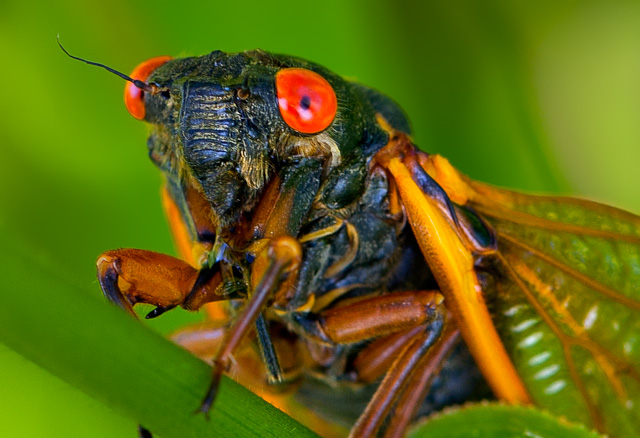
I'm Ready For My Close-Up Now, Mr. DeMille (Nikon D700 @ ISO 200; Nikon 105mm Macro @ F/11; 1/40 Sec, Tripod, MLU, Cable Release; Cropped) Photographing Cicadas:As mentioned above, the best time to photograph closeups is in the morning, when they are relatively immobile and approachable. For best results, photograph them in the shade. If you photograph them in direct light, you'll loose a lot of subtle details due to excessive contrast. I shot a mix of hand held and tripod supported, and they both have plusses and minuses. Hand holding makes playing around with composition easy. But it also requires high ISOs when shooting in the shade. The shot at the top of the page, for instance, was handheld at ISO 3200. Tripods allow much lower ISOs, but that means slow shutter speeds. These bugs like to sit on thin spindly stalks of grass that move in even the slightest breeze, so slow shutter speeds can be a problem. Additional Information:If you're interested in digging deeper - and there's a lot more to this subject than my brief introduction - the best book I've found on the subject is "Periodical Cicadas: The Plague And The Puzzle", by Gene Kritsky. Unfortunately, the Amazon listing is expensive. Alternatively, contact the Missouri Botanical Garden (Google it for the number) and see if you can buy one from them. That's where I found mine and it was relatively cheap. I don't know if they'll ship though. |
Affiliate Links

|
|
Copyright 2011 Hans Giersberg. All Rights Reserved. |